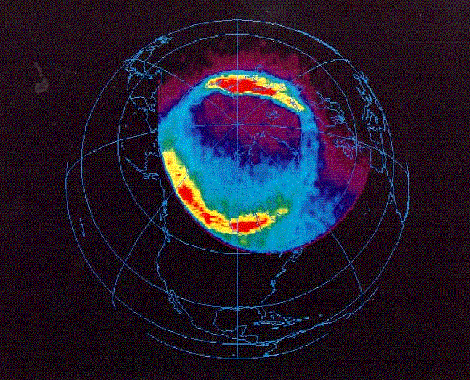Astronomy Picture of the Day
Discover the cosmos!
Each day a different image or photograph of our fascinating universe is
featured, along with a brief explanation written by a professional
astronomer.
May 27, 1996

Aurora Crown the Earth
Credit:
G. E. Parks
(
University of Washington) and the
UVI
Team,
Polar,
NASA
Explanation:
What do aurora look like from space? The
POLAR
spacecraft answered this by
photographing an auroral oval surrounding the north pole of the Earth,
causing displays on both the night and day side. The auroral sub-storm,
pictured in false-color above, developed within 15 minutes and may have
lasted as long as on hour.
Aurora are caused by charged particles
streaming away from the
Sun and towards the
Earth. As the particles fall
to Earth, they spiral along magnetic field lines and cause
colorful radiation. The
UVI experiment
onboard the POLAR spacecraft is
equipped with special filters that allow it to see
aurora in a band of
ultraviolet light
where sunlight is relatively dim. The more red the
emission depicted in the above photo, the more intense the radiation.
Earth's continents have been drawn in for clarity
Tomorrow's picture: The Pipe Dark Nebula
| Archive
| Index
| Search
| Glossary
| Education
| About APOD |




Authors & editors:
Robert Nemiroff
(GMU) &
Jerry
Bonnell (USRA).
NASA Technical Rep.:
Sherri
Calvo.
Specific rights apply.
A service of:
LHEA
at
NASA/
GSFC




